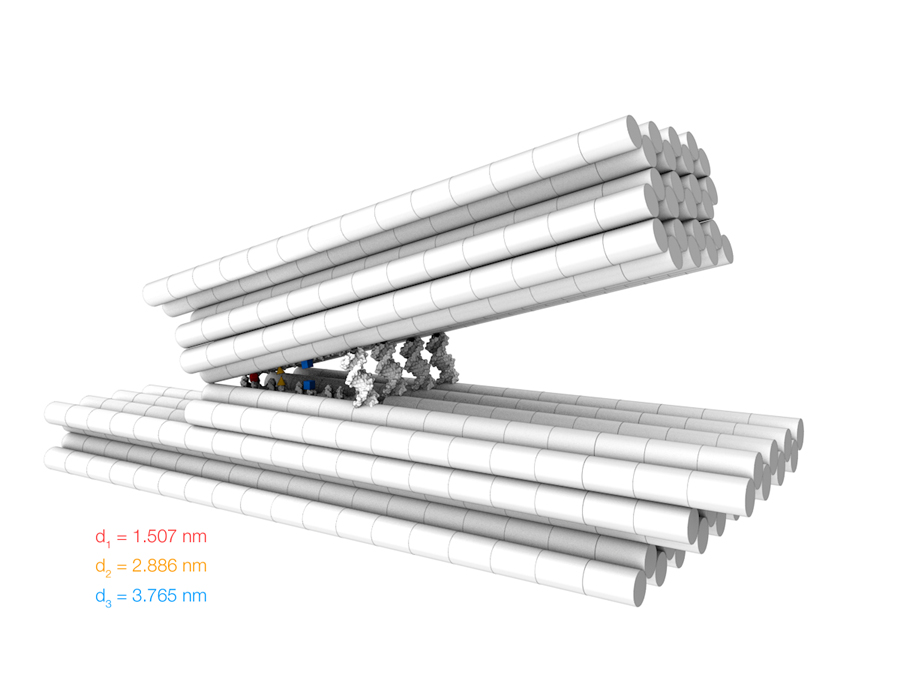Dietz lab's latest DNA nanomachines demonstrate dynamics and precision
Nanoscale rotor and gripper push DNA origami to new limits

Inspired by nature's nanomachines – such as the enzyme ATP synthase and the motor-driven flagella of bacteria – physicists in Prof. Hendrik Dietz's lab at TUM keep expanding their own design and construction repertoire. They have systematically developed rules and procedures for creating self-assembled DNA origami structures with ever greater flexibility and control. Moving from DNA basepair matching to shape-complementary building techniques – with a variety of interlocking "bricks" – the researchers' toolkit has advanced steadily in the direction of higher-level programming and modular assembly.
In step with this progress, they have honed methods needed to verify, for example, that a particular soup of nanoparticles really is packed with copies of whatever they designed: whether a switchable gear, an artificial membrane channel, an arbitrarily complicated test object, a "nanobook" that opens and closes, or a robot figure with movable arms.
Two new additions to the zoo
The latest additions to the lab's zoo of DNA origami objects, two tiny 3-D machines with moving parts, demonstrate new capabilities. (See video at EurekAlert, 1'23".)
Doctoral candidates Philip Ketterer and Elena Willner collaborated with Dietz in building a rotory mechanism from three multilayer DNA building blocks: a rotor unit, with a body roughly 32 nanometers long and a longer, lever-like extension; and two clamp elements that "click" together to form an axle bearing. The parts join with a tight fit and leave just 2 nanometers of play around the axle, allowing the rotor to swing but not to wobble. In one variant, the arm will rotate freely between random stopping points; in another, it will dwell in specified positions the researchers call docking sites. To date, this is the most complex rotary structure realized using DNA origami techniques.
To be clear, the rotor has no motor: It is propelled by Brownian motion, random movement of particles in solution. By demonstrating the feasibility of building such a machine, however, the researchers open the way for active devices under chemical or thermal power and control. "It’s like having built an engine," Dietz says. "Now spark plugs and combustible fuel are the next items on the to-do list."
In a separate project, Dietz and doctoral candidate Jonas Funke created a hinged machine on a scale suitable for manipulating individual molecules with atomic precision. The angle between the gripper's two main structural elements can be controlled with DNA helices. Experiments with this DNA origami positioning device showed that it could be capable of precisely placing molecules, adjusting the distance between them in steps as small as the radius of a hydrogen atom. This work is significant in that it bucks a trend in the field toward building larger DNA origami devices without necessarily pushing the limits of precision. In addition, the results hint at one of the ways DNA nanomachines might someday be useful to control chemical reactions.
"On the one hand," Dietz says, "we now really trust the placement precision within our structures – because we have actually placed two molecules and controlled their distance with atomic precision. On the other hand we have now a prototype rotary mechanism. Based on our measurements, its mobility is such that it could do up to 50,000 rpm if every rotary step it took would go only in one direction. In the next generation of devices, we will use the placement precision to couple chemical reactions to the movements of a rotor. This has the potential to result in a motor. This device, then, could be used for all kinds of purposes, such as actively propelling nanoscale drug-delivery vehicles, pumping and separating molecules across barriers, or packaging molecules into cargo compartments."
______
This research has been supported by the European Research Council (Starting Grant to H.D.); the German Research Foundation (DFG) through Excellence Clusters CIPSM and NIM as well as Collaborative Research Center (SFB) 863; the German-Israeli Project Cooperation; and the TUM International Graduate School for Science and Engineering.
Publications:
Philip Ketterer, Elena M. Willner, and Hendrik Dietz, "Nanoscale rotary apparatus formed from tight-fitting 3D DNA components." Science Advances 19 Feb 2016: Vol. 2, no. 2, e1501209.
DOI: 10.1126/sciadv.1501209
Jonas J. Funke and Hendrik Dietz, "Placing molecules with Bohr radius resolution using DNA origami," Nature Nanotechnology 11, 47–52 (2016). DOI:10.1038/nnano.2015.240
Video (free for use)
Animation (1'23") on EurekAlert.org
Contact:
Prof. Hendrik Dietz
Technical University of Munich
TUM Laboratory for Biomolecular Nanotechnology
Tel.:+49 (0) 89 289-11615
dietz@tum.de
http://bionano.physik.tu-muenchen.de
Technical University of Munich
Corporate Communications Center
- Patrick Regan
- presse@tum.de
- Teamwebsite